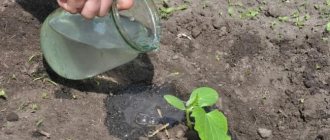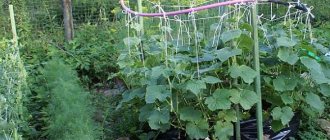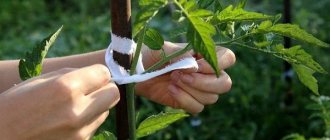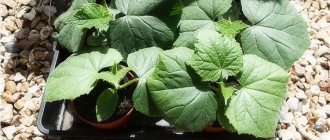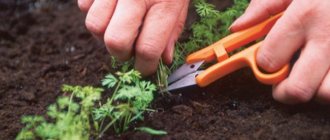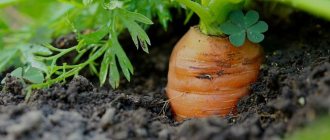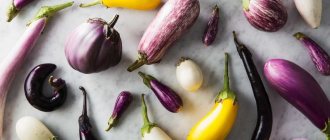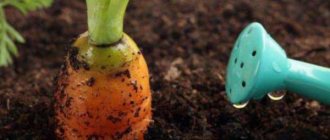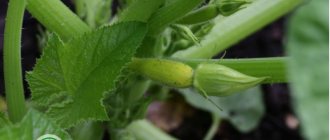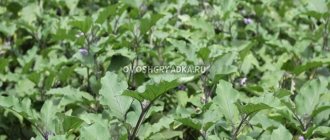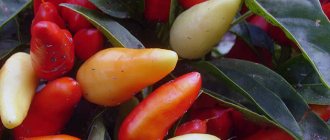Benefits of Garter Cucumbers
The structures do not require much space in the garden beds; they make the garden look neat and beautiful. By providing the bushes with support, the farmer frees up space for other crops. This method of growing cucumbers has other advantages:
- the support helps to correctly form the bush and carry out pinching in time;
- the branches develop better, become stronger, and produce larger fruits;
- the more securely the plant is tied, the longer the shoots it produces, on which a large number of ovaries are formed;
- watering plants is easier - water goes directly to the roots, does not affect the leaves, and therefore does not provoke diseases;
- contact between diseased and healthy vines is excluded;
- It is more convenient to collect fruits from bushes tied to a support; and pests are easier to detect.
Stems creeping along the ground quickly dry out or rot. If the bush itself begins to weave haphazardly in a vertical direction, the untied vines may break off under the weight of the fruit.
Methods for planting cucumbers on a trellis
You can grow tasty and healthy cucumbers in various ways. Let's consider the most convenient of them.
In the open ground
Seeds or seedlings of cucumbers are planted in either one or two rows. When planted in one row, the distance between rows should be 1.0–1.3 m, between plants in a row - about 25 cm. When planted in two rows, the distance between rows is 50–70 cm. The distance between plants in a row is 25– 30 cm. If you plant cucumbers too close to each other, they will interfere with each other’s development, which means the harvest will be weak.
A rail is attached above each row or trellis wire is pulled at a height of approximately 2 m from the ground. The gap between the pillars is 1.5–2.0 m. Between the pillars, under the top wire or lath, 2 more wires are pulled (at a height of about 15 cm, 100 cm from ground level), to which a mesh with cells measuring 15–20 cm is attached. Instead of a net, you can tie a rope to the top bar for each shoot, around which the stem is wrapped as it grows.
At 3–4 weeks of growth, when the stem length reaches 31–35 cm and 5–6 leaves have formed, you can begin gartering. It is more convenient to tie up young shoots of cucumbers because they are more elastic than the stems of mature cucumbers. The trellis is installed before planting the seedlings. You need to tie the plants under the first leaves not tightly, but loosely, without interfering with their development and growth.
The next stage is pinching, i.e., removing the top of the main stem (the carrier of male flowers that produces barren flowers) above the 5-6 leaf, in order to activate the growth of side shoots on which female flowers will appear, from which fruits are formed. Thanks to this procedure, the yield will be high and the cucumbers will not taste bitter. Pinching is carried out both in greenhouse cucumbers and in open ground plants.
During cold weather, throw a non-woven covering material over the trellis. Try to install the support so that they are closed from the wind; due to swaying in the wind, the yield can be significantly reduced. Place it near your house or shed.
It is easy to distinguish a male flower from a female one: the female one has an ovary in the form of a small cucumber, while the male one grows on a stalk
In the greenhouse
Planting cucumbers on a trellis in a greenhouse is done according to the same scheme as in open ground, only the distance between rows is 50–60 cm, and between plants in a row is about 40 cm.
Table: advantages and disadvantages of growing cucumbers on a trellis and spread
| Advantages | Flaws | ||
| trellis method | planting in spread | trellis method | planting in spread |
| ease of cultivation | labor intensity of construction |
|
Video: vertical cultivation of cucumbers in a greenhouse
Growing cucumbers on a trellis can significantly save time and space in the garden. and also reap a high harvest.
Rules for tying cucumbers in open ground
Below are several techniques for tying bushes to supports. Each of them will be successful if a number of rules are observed:
- in order not to damage the shoots, do not use hard (for example, clamps) or thin (wire, fishing line) materials for gartering;
- the best option is synthetic or fabric tapes that do not cut into the stem;
- you can use plastic strips fastened with a stapler;
- the binding loop should not be tight, otherwise the stem will break;
- Do not pull the twines (ropes) too tightly in a vertical trellis;
- the top of the stem must be twisted around the support in a timely manner; otherwise it will fall down and break.
Failure to follow the rules can lead to injury to the bush, which may not be immediately noticed. Subsequently, such a plant will become infected with a fungus.
Devices and materials for garters
Before planting cucumbers, it is recommended to choose one of the design options to which the bushes will be tied. Here the characteristics of the site and the capabilities of the summer resident himself are taken into account.
Popular types of supports:
- metal or plastic mesh;
- stakes made of metal or wood;
- natural trellis made of twine;
- arched arcs.
You should also take care of the material with which the vines are tied to the structure. The most common option is wide strips of cotton fabric.
Some summer residents use old tights. Nylon fabric is durable and at the same time quite soft. Synthetics stretch well, so the stems will not be pinched.
To help farmers, special reusable clips are available for sale. They reliably fix branches weighed down with fruits. And farmers who grow cucumbers on a large scale will find it convenient to use a stapler that is loaded with garter tape.
Harvesting
The first harvest of cucumbers grown on a trellis appears approximately 5-6 weeks after planting (the timing is determined by the varieties). Thanks to the supporting structures, you can comfortably collect fruits of different sizes, using them for various purposes:
- cucumbers less than 5 cm long ripen in 2-3 days and are excellent for pickling with spices. In one jar you can combine several small pickled vegetables (cucumbers, beans, cauliflower, corn);
- popular gherkins (fruits 5-6 cm long ripen in 5-6 days) are excellent for preservation;
- cucumbers up to 13-15 cm long are especially aromatic and juicy, so they are used fresh for making salads.
During the ripening process, it is important to promptly remove damaged or twisted fruits so that they do not waste nutrition. It is best to pick cucumbers in the morning or evening hours
Garter methods
There are as many ways to form branched plants as there are gardeners. Some methods are widely used.
Horizontal option
This method is most suitable for beginner gardeners - it is quite simple to implement. The main actions are as follows:
- on one side of the beds, at the ends, supports the height of a person are driven into the ground - metal pipes or wooden poles;
- several horizontal rows of strong twine are evenly stretched between the piles, maintaining a distance of 30-40 cm;
- When the bush reaches the desired height, begin tying the stems.
The first knot is formed on the bottom rope. When the shoot reaches the next row, make another garter, etc. When the stems reach the last string, make sure that the tops do not hang down. It is better to cut off the excess length immediately.
Vertical method
This option is also not particularly difficult, and in forming a trellis it is even simpler than the horizontal method. The garter is carried out following the following algorithm:
- to begin with, as in the previous description, you need to install 2 supports along the edges of the bed;
- but only one string is pulled - at the very top;
- Strips of fabric 5 cm wide are tied onto the support; their number is proportional to the number of planted bushes;
- the second ends of the tapes are fixed at the base of each plant.
The binding loop should be free so as not to interfere with the bush’s smooth development upwards. The length of the strips is chosen in such a way as to avoid strong tension.
Deadlines and rules for implementation
Before tying cucumbers in open ground, you need to let them get stronger. It is recommended to carry out the first garter when the height of the plant reaches 30 cm and 5 true leaves appear on it. At this stage, the base strengthens and begins to actively grow. Earlier tying is not advisable. In addition, when the plant reaches the desired height, the entire structure will have to be changed.
Following the recommendations below on how to properly tie cucumbers in open ground will help you complete this activity without errors:
- elements of the future design are prepared in advance so as not to miss the timing of tying;
- keeper tape or strips of soft fabric 2–3 cm wide are used as garter material, since thin synthetic threads can cut fragile cucumber shoots, and polyethylene twine will stretch under the weight of the fruit;
- fabric strips are wound around the stem, making a turn down, and then overlapping the turn upward, without tightening the loop too much - a finger should pass between the tape and the shoot;
- Tie cucumbers in the morning or evening so that accidental damage is healed before the sun begins to shine.
Related article:
Pinching cucumbers: why and how to do it
You should not tie up new shoots too often. Before tying cucumbers, you need to give the plant the opportunity to independently catch its antennae on the support. The process of further weaving just needs to be controlled and set in the desired direction. If the shoot does not have enough strength to hold the fruit or the tendrils are not enough to secure it, then it is necessary to make an auxiliary garter.
Other methods for gartering cucumbers
There are other options for fixing cucumber stems to supporting structures. They are not as popular as those described above, but they are not a curiosity either.
V-garter
This design is similar to the vertical one, but has its own peculiarity - instead of one ribbon, 2 strings hang from each bush. The lower ends are fixed together at the base, the upper ends are located at a short distance from each other. And it looks like a Latin V .
All that remains is to direct the shoots of the bush along two trellises, and then they will develop independently. Separation avoids crowding, and each leaf gets more light.
Garter of cucumbers on a net
This option is an excellent alternative to horizontal and vertical structures. For support, you can use a metal chain-link or buy a special synthetic mesh for spreading crops. It is easy to weave such a support with your own hands.
The mesh is traditionally stretched between 2 supports, or another method of designing the beds is used - in the form of a rectangle, triangle, etc.
How to tie cucumbers under arches
In this case, the supports will be located not along the beds, but across them - metal or plastic arcs are dug into the ground above each bush. There are many vertical twines hanging from them to the bushes, to which the mustache will cling.
Vertical ropes connect the arcs to each other. They are fixed at the highest point of the structure, and 30 cm from the ground. Several intermediate rows are also made. Their cucumbers can be used as additional support.
Hybrid option
The trellis over the bed is installed in the form of a triangle. The result is a volumetric support, somewhat similar to the arc version. However, it is structurally different. It is more rational to apply this method in a garden bed with 2 rows of cucumbers, following the following principles:
- at the beginning and end of each row, wooden stakes (metal rods) 1-1.5 m high are driven in and their upper ends are secured, forming triangles;
- depending on the length of the bed, 1-2 more intermediate “figures” are installed;
- the bottom of the base is connected by horizontal planks;
- in the same way, the vertices of all triangles are fastened into a single structure;
- From the top plank to the bottom, strings are lowered on both sides and securely fastened.
The gap between the ropes should not be large and have the same pitch along the entire length of the structure. This makes it more convenient to care for the garden bed, and the trellis looks neater.
Garter with stakes
This method is only good for short-climbing bushes. A powerful stick or a tall stake is installed near each plant (as is the case with tomatoes). Sometimes other supports are used - in the form of the letter “P” or a ladder.
Why is tying necessary?
The process of tying up bushes with cucumbers is a responsible, labor-intensive and time-consuming task, but it helps the gardener achieve positive results and not lose part of the harvest during the period of flowering and ripening of the fruit. So, let's take a closer look at why tying cucumbers is necessary:
- Correctly carried out garter makes it easier to care for the bush during the period of growth and harvesting without possible losses.
- Cucumbers tend to stick together with their tendrils, and proper garter prevents this.
- The garter is useful for the ripening of side shoots on which fruiting flowers appear.
- Open (thanks to tying) access to leaves, tendrils and stems greatly simplifies the care of the crop. The gardener removes diseased leaves without difficulty, the necessary shoots are pinched, and the tendrils of the cucumbers can be directed in the right directions. In addition, with the help of a properly executed garter, you can regulate the number of male and female flowers on the plant.
- Tying cucumbers helps prevent rotting and spoilage of the fruit, and reduces the risk of parasitic insects appearing on the plantings.
Tying cucumbers: benefits and why is it necessary?
The procedure is carried out so that they grow up and do not fall.
This must be done using strong materials so that they do not break under the weight of the fruit.
Advantages:
- Since the plant loves heat very much, without tying it up, you can lose a large part of your harvest during flowering, because in this case the cucumbers will creep along the ground.
And it turns out that the flowers are in somewhat darkened areas, which contributes to their withering.
When tied, all parts of your plant will be separately, that is, each of them will receive its own dose of sunlight.
- Cucumbers that are grown in the usual way are able to cling together with tendrils and thus intertwine with each other.
As a result, this interferes with their normal development and thus prevents it.
It also leads to the fact that you spend a lot of time trying to find the fruit you need among the dense green foliage.
- Tying saves you time and effort that you spend searching for cucumbers.
Since they are located on an elevation, which can be made even to the height of your height. This will provide even greater comfort for you.
You no longer have to bend over for each fruit. But this is very convenient, especially in cases where you have a large number of beds with this plant.
- When tying, already ripe fruits do not come into contact with the soil, which means that the rotting process will not start soon.
Unlike growing in the usual way, in which the hearths are on the surface of the soil and undergo faster wilting.
Is it necessary to tie cucumbers?
When answering the question about the importance of tying cucumbers, it is necessary to list the main reasons why all gardeners prefer to tie the plant.
All the positive aspects of the garter:
- a tied cucumber produces longer shoots, that is, it increases the area for setting inflorescences, which means the amount of harvest will increase;
- being infected with a fungus or virus, a cucumber on a support throws out new shoots upward, which allows them to grow healthy;
- a climbing plant takes up minimal space in the garden, growing vertically;
- It is easier to harvest without looking for fruit on the ground under the leaves.
Do cucumbers need to be tied ? Without a garter, they will also bear fruit, but then the cucumbers will not produce long shoots and the harvest will not be so abundant. Some cucumber stems break under the weight of the crop without support. Many fruits will have a twisted appearance, and some will even rot due to the wet soil.
General rules
- What materials to use.
The best material for tying a cucumber is soft fabric ribbons (cotton, linen, knitted) with a width of 3 to 5 cm and a length of up to 25 cm. Moreover, they must be strong enough, since the plant with fruits will have significant weight. It is better not to use materials that can stretch and fall out.
To tie it to a horizontal support, you will need soft linen twine or long, strong fabric ribbons.
The materials used to construct the support include metal wire, mesh, strong rope, wooden blocks, and poles.
- When to tie up.
The garter begins when the plant reaches a size of 35-40 cm. By this time, the cucumber will have 4-6 true leaves and will independently hold itself in an upright position.
The main rules for tying cucumbers: how and what to tie?
Gartering should begin approximately 4 weeks after the start of intensive growth of cucumbers. At a time when they reach a height of more than 40 centimeters.
Please note that the plant must have at least five formed large leaves.
You should start tying as early as possible, when you are sure that the plant is mature enough. This is due to the fact that young bushes are easiest to tie up.
Since they are able to bend well and take the shape you need, but old stems quickly become hard and when you try to give them the desired position, they will immediately break.
There are several types of garter, which one is best for you to decide:
- Horizontal.
- Vertical.
- Mixed method.
In order to do the tying, you will need to prepare all the necessary materials in advance.
To do this, you will need to acquire long, thin sticks made of any materials that will serve as pegs for you.
You will also need fishing line, rope or pieces of fabric for tying; here, in choosing the material, you can be guided by what you have available.
What tools will you need?
To work you will need:
- Hammer;
- Screwdriver;
- Pegs;
- Garter material;
- Nails;
What materials can garters be made from?
There are a large number of options for what you can use to tie up your bushes.
You can choose the method you like and follow it.
Many gardeners combine several types of garters, remembering which is which.
Then they observe how each of them behaves throughout the plant's growth. Then, guided by this information, they make an appropriate decision on what is best to use as a tied material next year.
- Cotton fabric - in this case, various scraps of fabric are used, the width of which is about 5 centimeters, small pieces of fabric are tied to each other and thus a long rope is obtained, with the help of which the branches of cucumbers are tied up.
- Twine - in this situation, a tourniquet is used that has side slits. It is best to use just such a material, as it is able to fix the branches of cucumbers using threads.
- Branches - thin branches are used, which should be prepared in advance. To prepare, you need to cut off all the lateral leads and the bark covering their surface.
- Trellis are the same as cotton garters, but in a thicker size. Thin pieces of cotton can quickly deteriorate; if they are in open areas, they can rot. But stronger fabric will last a little longer.
When is the best time to tie cucumbers?
After planting, when the cucumber stem reaches 30 cm and 4-6 leaves appear on it, it’s time for tying. Until this time, the plant does not need support. After this time, gartering is also possible, but there is a risk of breaking the plant stem.
Until the cucumbers have grown to the required length, you can prepare the area for the upcoming tying:
- drive in stakes;
- pull the ropes;
- put a net.
How and when is it time to form a bush?
It is best to start forming a bush when it has reached normal size in height. This is done because it is inconvenient to tie up a small bush.
It is not yet fully formed and has very fragile stems. Therefore, if you undertake this procedure with such a plant, you risk damaging it, which will lead to its further withering.
Correct formation of cucumber bushes
Cucumbers need to not only be tied up, but also formed into neat bushes so that the plant spends energy not on developing extra vines, but on fruits. Begin the procedure even before the time comes to secure the stems to the support:
- at the stage of 3-4 true leaves, the stepsons and the first female flowers are removed from the bush;
- When side shoots appear, they are pinched according to the following pattern:
- first over the 2nd sheet;
- the next pass, when the bush has grown to the trellis, pinch the shoots in the axils of the upper leaves, leaving 2-3 pieces untouched. (the main stems are formed from them).
When the shoots reach the top line of the trellis, their tops are not tied up, but thrown over the wire and pinched, thereby stopping growth. In addition to the traditional method of forming bushes, experienced summer residents offer another, original option.
cucumber tree
Hearing the phrase “cucumbers grow on trees,” many will take it as a joke. But there is some truth in the statement - fruits can indeed be grown on a tall, tree-like bush. The main thing is to form it correctly.
Not only the central shoot, but also the lateral stems participate in development. A cucumber tree is formed according to this principle:
- the main stem is well fixed on the trellis;
- side shoots are pulled to the sides, fixed a row lower;
- when female ovaries appear, the side stems are brought closer to the central one so that an angle of 60 degrees is formed between them.
The tendrils from the main shoot are wrapped around the side shoots, trying not to injure them. When excess shoots appear, they are removed.
Stepsoning
This stage consists of removing side shoots and is carried out on a regular basis.
It is important to remove stepsons when their length ranges from three to five centimeters. If you delay removal, the plant will take longer to recover, which will affect its growth and fruiting
In addition, if you choose a variety with lateral arrangement of female flowers, incorrect pinching can even lead to loss of harvest if you cut off more than expected. But if this step is carried out correctly, the fruits will appear and ripen earlier.
Correctly carried out pinching stimulates the plant to accelerate growth and earlier harvest.
How to grow cucumbers without a garter
It was mentioned above that some summer residents practice growing cucumbers as a carpet spreading along the ground. This is inconvenient and harmful to plants and crops. If you don’t want to bother with garters, you can use other options, allowing the bushes to find their own support:
- if there is a suitable area for a garden bed near the fence, then cucumbers are planted next to it;
- you can combine crops by planting corn or sunflowers next to the cucumbers (this is an excellent support for climbing plants);
- Bushes feel good under low, slightly dense trees.
At the beginning, you will have to make sure that the shoots do not spread to the sides, but that the tendrils grab onto the natural support.
Read more in the article: Methods of planting cucumbers in open ground
How to grow cucumbers in a barrel
Summer residents with small plots can grow cucumbers in wooden or metal containers. Such a mini garden bed will not only solve the problem of lack of space, but will also decorate the yard. In addition, the container can be installed in any convenient place on your site (even near the porch).
The lower part of the barrel needs to be filled with compost, on top of which soil is poured to the top. If the container is wide, you can safely plant 3 bushes of the same variety, placing them according to the “star” principle. The grown loops will begin to hang from the barrel and reach towards the ground. A garter is not required here, and the stems in an ampel form do not touch the ground, the cucumbers do not get dirty.
The main thing is not to forget to make drainage holes in the container. Otherwise, the water will stagnate in the barrel and provoke the development of putrefactive spores.
Why tie up cucumbers?
Cucumbers are a tropical vine that grows in our climate only in the warm season and exclusively as an annual plant. All experienced gardeners know that it is advisable to provide cucumbers with support for weaving. This is due to the fact that cucumbers weaving “in the spread” in the garden will soon occupy all the available space in their garden bed and begin to throw vines onto neighboring ones. Growing without control from the gardener, cucumber vines can choke out peppers, tomatoes, dill, parsley or eggplants growing in the neighborhood.
Since the cucumber is a vine, its stems in each internode have special tendrils for attachment to supports. With the help of these tendrils, the plant easily climbs to any height, tightly and firmly wrapping itself around a base that gets in its way (a tree, a ladder, a house wall, a fence). With the onset of autumn, this cucumber expansion is stopped by cold weather: at a temperature of + 10 °C, the tropical inhabitant stops growing, and when the temperature drops below 0 °C, it dies altogether. If it were not for frost, one cucumber plant could cover the entire surrounding space.
Tendrils for fastening appear on an adult plant, and the gardener must tie young cucumbers to the supports manually. Inexperienced farmers are not sure whether they need to tie up cucumbers, but experienced gardeners always do this and invariably get a good harvest.
- Benefits of a garter:
- saves space in the garden;
- it is convenient to loosen the soil near the root system and hill up the bushes;
- you can supply water directly to the roots of the plant by drawing a small longitudinal ditch or laying out a drip irrigation tape at the foot of the plants;
- when watering, water and dirt do not fall on the leaves, which reduces the chance of the plant getting fungal diseases;
- it is convenient to form lateral stems and regulate the load of vines with fruits;
- Harvesting is made easier - all the fruits hang in plain sight;
- when harvesting the fruits, the leaves and stems are not injured, which is very important, since the cucumber is a very fragile plant, and after 2-3 turns of the vine, the stem or leaves begin to dry out and die;
- it is convenient to carry out preventive or therapeutic treatment against diseases (spraying preparations on the leaves).
Did you know? Cucumber contains a very important substance: tartaric, or dioxysuccinic acid. This acid is important because it prevents the conversion of carbohydrates obtained from food into fat. That is why nutritionists add cucumbers to any menu for those who want to keep their weight under control. This vegetable has extremely few calories, is a good diuretic and an excellent body cleanser (detoxifier).
Useful tips for gardeners
Experienced gardeners learned the science of agricultural technology from their mistakes. In order for novice summer residents not to go such a long way to obtaining good harvests, they should immediately take into account the recommendations of experienced farmers.
When developing independently, the bushes send out lashes at random, growing in all directions. Often side shoots entwine the main stem, preventing it from growing, and sometimes causing injury. To avoid this, it is recommended not to ignore garters, taking into account many nuances.
- It is advisable to guide each side shoot along a separate rope.
- Some gardeners try to grow a bush more than 1.5 m high on a trellis. This is undesirable - the upper leaves will begin to create shadow, preventing the development of lower shoots. The main thing is to pinch the top in time to stop growth and redirect forces to the development of lateral stems.
- When choosing material for tying, take into account the design option. For example, in a vertical trellis the rope must be stronger than in a horizontal one - it alone takes on the entire load of the weaving shoot.
- If the prevailing factors in choosing a support are simplicity, convenience and low cost, then among the traditional options the most suitable method is horizontal.
- For tying manipulations, choose the morning hours so that the plants have time to adapt to new conditions before the onset of the afternoon heat.
Some gardeners complain that tying is not a very practical option for caring for cucumbers. They justify their opinion by the fact that the crop on the trellis does not receive the moisture it needs.
But this disadvantage can be easily corrected - it is enough to provide the bushes with timely watering. To ensure that the roots are fully saturated with water, it is reasonable to install a drip system on the beds. Then the cucumbers on a “leash” will not be afraid of any drought.
Which method to choose depending on the variety
When choosing a garter method, it is important to consider the variety grown in the garden:
- Vertical tying to a trellis is suitable for hybrids and small-fruited bee-pollinated varieties of cucumbers.
- For cucumber varieties that do not form stepsons, it is not advisable to install a vertical support. The effort, time and materials spent on installation will not affect the size of the crop.
- For very curly cucumbers, the horizontal tying option is well suited.
- Garter on arches, mesh, or vertical trellis is suitable for cucumbers with a bunched type of ovary formation.
Before installing the support, you need to study the characteristics of your variety. The type of stem growth, the size of leaves and fruits and some other features are taken into account.
